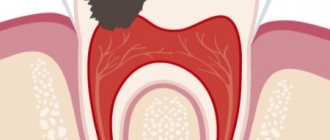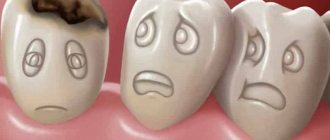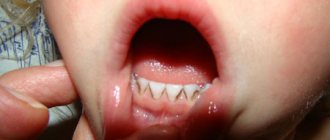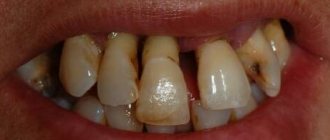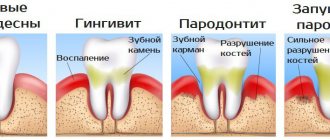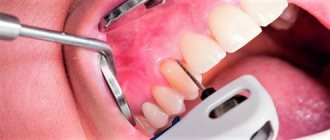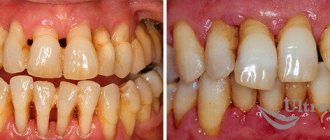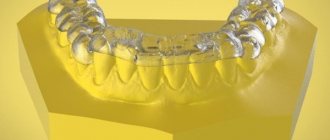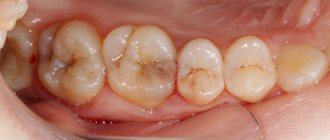The term “chronic generalized periodontitis” refers to a disease of a degenerative-dystrophic nature. During the course of the pathological process, destruction of the alveolar process - the bone structure - occurs. At the same time, periodontal tissues are affected. Currently, the disease is a serious dental problem. This is due to the fact that chronic generalized periodontitis is difficult to treat. At the same time, the disease often becomes the cause of the development of other pathologies in the body.
Development mechanism
The periodontal tissues located in the oral cavity are referred to as “periodontium”. They have a common blood supply and innervation. The tissues are also interconnected both functionally and morphologically.
The periodontal complex includes the gums, alveolar processes, periodontium, cementum of tooth roots. Normally, it performs reflex, support-holding and protective functions.
Under the influence of various unfavorable factors in the periodontal complex, the process of development of dystrophic changes of an inflammatory nature begins. As a result, both soft and bone structures begin to collapse. If all tissues of the complex are involved in the pathological process, it is customary to speak of generalized periodontitis.
In the absence of timely treatment, the disease progresses and becomes chronic. The latter is characterized by constant alternation of periods of remission and exacerbation.
According to the International Classification of Diseases (ICD-10), chronic generalized periodontitis is assigned code K05.3.
Forecast and preventive measures
If treatment is started in the early stages of the pathology, this leads to remission and the possibility of its extension. In restoration measures and in the process of preserving tissue functions, compliance with recommendations related to the implementation of preventive measures plays an important role. If the disease is advanced, the prognosis is unfavorable. This may be due not only to the loss of almost all teeth, but also to the fact that severe systemic complications will begin to develop, especially in the cardiovascular system.
The preventive complex involves compliance with a number of care and hygiene measures:
- timely brushing of teeth;
- a competent choice of cleaning products and tools - toothpastes, powders, brushes, threads;
- regular implementation of professional hygiene;
- timely treatment of emerging diseases;
- removal of deposits from the teeth;
- carrying out treatment of concomitant pathologies.
With these simple measures you can prevent illness and feel great.
Thus, generalized periodontitis is a serious disease that tends to constantly develop and progress. In this regard, it is necessary to diagnose it in a timely manner and take therapeutic measures. This approach will prevent complications and keep all teeth normal, eliminating unpleasant symptoms and improving the patient’s well-being.
Laser gingivotomy - surgical treatment of complex forms of periodontitis
Open and closed curettage of periodontal pockets
Catarrhal and hypertrophic gingivitis symptoms and treatment in adults
The roots of the teeth are exposed - what to do and how to treat them
Laser gingivectomy in the area of one tooth
Splinting teeth for periodontitis with fiberglass and tape
Causes
The development of the disease can be initiated under the influence of both local and systemic provoking factors. The first include the following causes of chronic generalized periodontitis:
- Incorrect or insufficient adherence to hygiene rules. Poor cleansing promotes the proliferation of pathogenic microorganisms in the oral cavity. In addition, the use of too hard brushes and toothpicks leads to injury to periodontal tissues. Inept aggressive movements when cleansing the oral cavity are also important. Excessive hygiene also often causes the development of generalized periodontitis. Against the background of frequent cleansing, an imbalance of microflora occurs.
- Malocclusion.
- Violation by the doctor of the algorithm of actions in the process of dental prosthetics.
- Too intense work of the chewing muscles.
- Closely and crowded teeth.
- Caries.
- Tobacco smoking.
- Avitaminosis.
- Intoxication of the body with salts of heavy metals.
- Leukemia.
- Disruption of the body's defense system.
- Pathologies of the digestive system.
- Vascular dysfunctions.
- Hormonal imbalance.
Systemic causes of the development of chronic generalized periodontitis:
Against the backdrop of the development of the above pathologies, nutrients practically cease to flow into the tissues of the periodontal complex. As a result, teeth become mobile and gum pockets begin to form. The latter gradually fill with purulent contents over time.
Doctors separately identify a cause such as osteoporosis. Scientists have noticed that in patients with chronic generalized periodontitis, not only the alveolar process is destroyed. Bone mass decreases throughout the body. Based on the results of numerous studies, Russian scientists concluded that the severity of generalized periodontitis is directly proportional to the decrease in the density of bone structures. Such conclusions made it possible to adjust the treatment regimen for the disease. Thus, in the treatment of chronic generalized periodontitis, the stage at which all actions are aimed at strengthening bone tissue throughout the body is of particular importance.
Causes of generalized periodontitis
One of the main reasons for the development of the destructive-inflammatory process is infection caused by specific pathogenic microorganisms. Subgingival plaque is the optimal environment for their reproduction. Its appearance is promoted by tobacco smoking, a short frenulum of the tongue, and malocclusion, which make it difficult to clean teeth properly.
Other causes of generalization of inflammation:
- untreated mechanical dental injuries;
- predominance of hard or soft foods;
- demineralization of enamel;
- living or working in unfavorable conditions;
- genetic predisposition;
- disruption of the salivary glands;
- irregular professional cleaning;
- transformation of dental plaque into plaque and stone;
- external infections introduced during poor-quality treatment.
Symptoms
The severity of clinical manifestations directly depends on the nature of the disease. At the initial stage of development of pathology, patients are concerned about the presence of the following conditions:
At the same time, shallow pockets are formed. In most cases, a person’s well-being does not deteriorate. As a rule, at this stage, patients rarely see a doctor. As a result, the pathology progresses.
Gradually, the following signs are added to the above:
If left untreated, chronic generalized periodontitis becomes advanced. This stage is characterized by a significant deterioration in the quality of life. The patient develops the following symptoms:
When the disease goes into remission, the person’s general condition improves somewhat. The gums acquire a pale pink tint, and bone tissue temporarily stops deteriorating. But at the same time, the roots of the teeth remain exposed, and purulent contents continue to flow out of the pockets.
Causes of chronic periodontitis
As statistics show, today various forms of periodontitis are registered in 90-95% of the population; people aged 33-45 years (from 60 to 95%) and 16-20 years old (from 55 to 90) are at risk. %). Tooth loss with this dental disease is recorded five times more often than, for example, with caries.
Periodontium is the tissue that holds the tooth (bone, mucous membrane, ligaments and gums). With periodontitis, the infection enters the space between the tooth and the gum, destroying the ligament between the tooth root and the bone.
The course of periodontitis is adversely affected by poor-quality oral care and tartar deposits. At the initial stages of the development of the disease, the symptoms are mild, mainly bleeding gums and weakness of the dental ligament, sometimes plaque on the teeth and viscous saliva are recorded. When the disease is active, due to the rapid destruction of the alveolar processes, tooth loss is observed.
Severity
The development of the disease goes through several stages. Depending on the severity of the existing disorders, the following degrees of the disease are distinguished:
The disease is also classified according to the frequency of exacerbations. They can occur up to 2 times a year. In such cases, it is customary to talk about frequent exacerbations. Episodes of deterioration in health may occur once every 3 years. In this case, we are talking about chronic generalized periodontitis with rare episodes of exacerbation. In some patients, no change in periods is observed. This indicates the presence of a chronic disease without exacerbations.
Diagnosis of chronic periodontitis
The diagnosis of chronic periodontitis is made by a periodontist. If necessary, other specialists can be involved in the diagnosis of concomitant diseases: cardiologist, gastroenterologist, hematologist, endocrinologist, rheumatologist, allergist, etc.
The most important diagnostic measure during a patient examination, which helps to recognize and evaluate the disease, is measuring the depth of the gingival sulcus - the gap between the tooth and the gum. Using a periodontal test placed between the tooth and gum, the dentist measures the depth of the space. If the depth does not exceed 2-3 mm, the gums are healthy. A depth of more than 5 mm indicates a pathological process.
Also an important step in diagnosis is assessing the hygienic condition of the oral cavity, and the integrity of the jaw bone tissue can be assessed using an x-ray. At the initial stage of localized periodontitis, osteoporosis is recorded in the upper and middle third of the interalveolar septum, destruction of its cortical plate. The compact jaw plate is preserved. If the process progresses, then resorption of the interalveolar septa occurs, promoting the formation of bone pockets.
Based on gum biopsy data, localized periodontitis is differentiated from periodontal disease and gingivitis.
Diagnostics
When the first warning signs occur, you should contact your dentist. The specialist will conduct an initial diagnosis, based on the results of which he can additionally refer the patient to a surgeon, orthopedist, or periodontist.
During the admission process, the doctor carries out the following activities:
Based on the results of the initial diagnosis, the doctor issues a referral for a comprehensive examination. It includes:
- PCR analysis.
- Bacterial culture of pathological contents of pockets.
- Saliva examination.
- Blood chemistry.
- Periodontogram.
- Orthopantomography.
- X-ray.
- Gum biopsy.
Having received the research results, the doctor makes an accurate diagnosis, displays this information in the patient’s card, notes the disease code according to the ICD (chronic generalized periodontitis - K05.3) and draws up the most effective treatment regimen.
Treatment
The approach to the disease directly depends on the degree of its severity. At the initial stage, conservative methods of therapy are used. In addition, the measures taken help to increase the duration of the remission period.
The treatment regimen for mild chronic generalized periodontitis includes the following points:
In most cases, after carrying out the above measures, the patient enters a period of remission.
Exacerbation of chronic generalized periodontitis of moderate severity requires the following procedures:
Treatment of chronic generalized severe periodontitis involves performing all of the above actions. Additionally, the following treatment methods are indicated:
If indicated, plastic surgery of the tongue, vestibule of the oral cavity or lip frenulum is performed. In some cases, surgical intervention is performed, after which the bite changes.
In the presence of chronic generalized periodontitis in the acute stage, physiotherapeutic treatment (electro-, ultra- and magnetophoresis) is additionally indicated. The patient’s condition can be improved and the onset of remission can be accelerated with the help of ozone therapy, hirudotherapy and herbal medicine.
Periodontitis
Introduction
In our country, we use the terminology and classification of periodontal diseases approved at the XVI Plenum of the All-Union Society of Dentists.
Periodontitis is an inflammation of periodontal tissues, characterized by progressive destruction of the periodontium and bone of the alveolar process of the jaws.
Gravity:
light, medium, heavy.
Flow:
acute, chronic, exacerbation, abscess, remission.
Prevalence:
localized, generalized.
Periodontitis is an inflammation of periodontal tissues, characterized by destruction of the periodontal ligaments and alveolar bone.
Flow:
chronic, aggressive.
Process phases:
exacerbation, remission.
The severity is determined
according to the clinical and radiological picture. Its main criterion is the degree of destruction of the bone tissue of the alveolar process (in practice, it is determined by the depth of periodontal pockets/PC/mm).
Severity:
light (PC no more than 4 mm), medium (PC 4-6 mm), heavy (PC more than 6 mm).
Process prevalence:
localized, generalized.
The commission considered it necessary to identify an independent group of periodontal diseases - aggressive forms of periodontitis (prepubertal, juvenile, rapidly progressing. The latter develops in individuals aged 17 to 35 years).
Chronic generalized periodontitis
mild severity
It develops as a complication of untreated chronic catarrhal gingivitis and is characterized by progressive destruction of periodontal tissue and bone of the alveolar processes of the jaws.
Clinic:
It is characterized by an almost complete absence of unpleasant subjective sensations in the patient, hence the low demand for medical help at this stage of the disease. Patients, as a rule, note slight itching in the gums and bleeding due to mechanical irritation (when brushing teeth, eating hard foods). The general condition is not disturbed, although an in-depth, targeted examination usually reveals changes in the immune system, deviations from other organs and systems, pathogenetically associated with periodontal pathology. From the anamnesis it should be clear that the disease began gradually and was practically asymptomatic for a long time.
An objective examination reveals chronically mild inflammation of the gums (swelling, bleeding, hyperemia). Supra- and subgingival dental deposits (mineralized and non-mineralized) are detected. The teeth are motionless and not displaced.
Diagnostic criteria
are: the presence of periodontal pockets up to 3.5 mm deep, mainly in the area of interdental spaces, and the initial degree of destruction of the bone tissue of the alveolar process (x-ray picture: absence of a compact plate at the apexes of the interalveolar septa, foci of osteoporosis, expansion of the periodontal gap in the cervical region).
To make a diagnosis
in this case, it is enough to question the patient, examine the oral cavity, probe clinical pockets, assess tooth mobility, conduct the Schiller-Pisarev test, as well as indication and quantitative assessment of “dental” plaque. To clarify the diagnosis, an X-ray examination is performed, preferably orthopantomography. It is advisable to do a clinical blood test, and for patients over 40 years of age, a blood glucose test. The listed methods, as a rule, are sufficient to diagnose mild chronic generalized periodonitis, if it is not accompanied by pathology of internal organs, pronounced occlusal disorders, etc.
Treatment:
Conducted in 3-4 visits. First, after antiseptic treatment of the gums, dental plaque is thoroughly removed. It is advisable to apply antimicrobial and anti-inflammatory drugs to the gums. Antimicrobial agents that are effective in this case are 0.06% chlorhexidine solution and metronidazole (Trichopol). Among anti-inflammatory drugs, preference is given to non-steroidal anti-inflammatory drugs (NSAIDs) - acetylsalicylic acid, indomethacin, ortofen.
The patient is taught the rules of oral hygiene, helped to choose a toothbrush and toothpaste, and given recommendations on the use of floss. At this stage, toothpastes with anti-inflammatory and antimicrobial effects should be recommended, as well as oral baths with antiseptic solutions, decoctions of chamomile, sage, and calendula.
Physiotherapy gives good results: AF on the gum area (antibacterial effect), anode galvanization, electrophoresis of medicinal substances from the anode (calcium chloride, vitamin B1), UHF EP in an oligothermic dose, local hypothermia, helium-neon laser radiation, argon plasma flow (anti-inflammatory Effect).
Periodontitis, as a rule, is accompanied by functional overload of the teeth, so the patient must be referred to a consultation with an orthopedist for selective grinding and other types of orthopedic treatment.
On the second, third and fourth visits (with an interval of 1-2 days), the level of oral hygiene is checked, the removal of dental plaque, and the application of pastes based on metronidazole and NSAIDs are continued. After the inflammatory phenomena are relieved, the granulations are scraped out - curettage. This procedure improves long-term treatment results.
After the described course of therapeutic manipulations, as a rule, the disease goes into remission.
A follow-up examination is scheduled after 3-6 months.
Chronic generalized periodontitis
moderate severity
It is the result of further progression of the inflammatory-dystrophic process in the periodontium. This stage of the disease is characterized by more pronounced clinical symptoms and noticeable dysfunction of the dental system, which forces the patient to seek medical help.
Clinic:
It is characterized by complaints of bleeding gums, sometimes soreness, bad breath, mobility and displacement of teeth. The general condition, as a rule, is not disturbed, although an in-depth examination reveals changes in the immune system, signs of endogenous intoxication, and deviations from other organs and systems.
When examining the oral cavity, signs of chronic gum inflammation are revealed: hyperemia, bleeding, and there may be purulent discharge from clinical pockets. There are supra- and subgingival deposits. As a rule, there is mobility of teeth of the I-II degree, and their displacement is possible.
Diagnostic criteria
allowing the diagnosis of “chronic generalized periodontitis of moderate severity” are: the presence of periodontal pockets up to 5 mm deep and resorption of the bone tissue of the alveolar process according to the radiograph at 1/3-1/2 of the height of the interdental septum.
For
To examine the patient and
make a diagnosis
, in this case we recommend performing the following scope of diagnostic procedures: questioning, examination, probing of clinical pockets, assessment of tooth mobility, Schiller-Pisarev test, indication and assessment of “dental” plaque. An X-ray examination (orthopantomography) is required. In addition, you need to do a clinical blood test and a blood glucose test. The patient should be consulted by an orthopedic dentist, and if indicated, by an internist.
A course of treatment
chronic generalized periodontitis of moderate severity consists of 6-10 visits over 20-30 days.
The therapy is aimed primarily at eliminating periodontal pathogenic factors (removal of dental plaque, selective grinding of teeth, plastic vestibule and frenulum, etc.), as well as stopping inflammatory phenomena in the gums, eliminating periodontal pockets, stabilizing protective rows, normalizing trophism, microcirculation and protective reactions in periodontal tissues.
On the first visit after examination and drawing up a complex therapy plan, antiseptic treatment of the gums is carried out with a 0.06% solution of chlorhexidine, 1% solution of hydrogen peroxide, 0.2% solution of furatsilin. Then supragingival and accessible subgingival dental deposits are removed. Usually, dental plaque removal is carried out in 2-3-4 visits, although this procedure can be carried out in one visit.
The patient is taught the rules of oral hygiene, helped to choose a toothbrush and toothpaste, and given recommendations on the use of floss. At this stage, toothpastes with anti-inflammatory and antimicrobial effects should be recommended. At home, the patient is also recommended to make oral baths with a solution of furatsilin (1:5000), chlorhexidine 0.06%, decoctions of chamomile, sage, calendula 3-4 times a day for 20 minutes after meals.
Oral hygiene should be monitored throughout the entire course of treatment.
During the same visit, they decide on the removal of damaged teeth, teeth with degree III mobility, replacement of defective fillings, incorrectly made dentures, and selective grinding of teeth.
The first visit ends with an application to the gums and the introduction of a paste consisting of an antimicrobial drug (metronidazole) and a non-steroidal anti-inflammatory drug (aspirin, ortofen, etc.) into the clinical pockets. In case of severe suppuration, local use of proteolytic enzymes (trypsin, stomatozyme, imozymase) and sorbents (helevin, digispon) is also advisable.
Metronidazole is prescribed orally: on the first day - 0.5 g 2 times (with an interval of 12 hours), on the second day - 0.25 g 2 times (every 8 hours). The drug is taken during or after meals.
It is advisable to combine the treatment with physiotherapeutic procedures that have antimicrobial and anti-inflammatory effects: KUF, gum hydromassage, anode galvanization or electrophoresis of medicinal substances from the anode, local hypothermia, etc.; per course - 3-7 procedures. On the second visit (after 2-3 days), the patient’s compliance with oral hygiene recommendations is assessed; for this purpose, plaque is stained with iodine-iodine-potassium solution. They continue to remove accessible dental plaque, rinse the pockets with antiseptic solutions from a syringe with a blunt needle, apply to the gums and inject a mixture of metronidazole and one of the NSAIDs into the pockets.
After stopping the inflammatory phenomena in the gums, they begin to eliminate periodontal pockets. For moderate periodontitis, “open” curettage is performed for this purpose. In a clinic setting, it is advisable to perform this operation on one segment of the jaw, i.e. in the area of six teeth, in a hospital setting - in the area of all teeth of one jaw. “Open” curettage is completed by applying a gingival protective bandage for 1-2 days.
“Home” recommendations: for the area of the postoperative wound - cold, antiseptic mouth baths, careful hygienic care of the oral cavity, limiting the consumption of rough, spicy and irritating foods.
During subsequent visits, quality control of earlier operations and “open” curettage of periodontal pockets in the area of other teeth are carried out, preferably against the background of antibacterial therapy.
After removing dental deposits, eliminating other periodontopathogenic factors, stopping the inflammatory process in the gums and eliminating periodontal pockets, periodontitis goes into remission.
At this stage, therapeutic measures should be aimed at normalizing microcirculation, nervous trophism and homeostasis of periodontal tissues. Although, to a large extent, these processes normalize on their own after the elimination of the microbial attack and the inflammatory process in periodontal tissues.
Usually, to solve the problems listed above, physiotherapy is prescribed (5-10 procedures per course): cathode galvanization or electrophoresis from the cathode of nicotinic acid, aloe extract, heparin, etc., darsonvalization of the gums, INGL, UHF EP in an oligothermic dose, local hypo -hyperthermia. Injection administration of vitamins, stimulants and other medications along the transitional fold is also acceptable (10-12 injections per course).
After completing the course of treatment, the patient is taken for clinical observation and a follow-up examination is scheduled after 2-3 months.
All subsequent treatment and preventive measures should be aimed at maintaining the protective forces of the periodontium and preventing the formation of dental plaque. For this purpose, periodic follow-up examinations and courses of “maintenance” therapy are carried out at intervals of 2-3, and then 5-6 months. Their main goal is to control oral hygiene, timely removal of dental plaque, stimulation of trophism, microcirculation and the protective forces of periodontal tissues in order to prevent exacerbation and further progression of the disease.
Chronic generalized severe periodontitis.
It is an advanced, often “terminal” stage of the inflammatory-dystrophic process in the periodontium. Treatment in this case, unfortunately, is usually ineffective, leads only to short-term improvement and requires significant efforts from the doctor and the patient in order to maintain the relative usefulness of the dental system for some time and delay tooth loss.
Clinic:
It is characterized by complaints of bleeding and sore gums, bad breath, mobility and displacement of teeth, and difficulty chewing food. As a rule, the general condition of the patient is disturbed. An in-depth examination reveals endogenous intoxication, changes in the immune system, abnormalities in the internal organs, pathogenetically associated with the inflammatory-dystrophic process in the periodontium.
An objective examination reveals severe chronic inflammation of the gums with suppuration from periodontal pockets, periodic exacerbations and abscess formation. There are supra- and subgingival dental deposits. There is pronounced traumatic articulation, pathological mobility of teeth of II-III degree, and their displacement.
Diagnostic criteria
, allowing the diagnosis of “chronic generalized severe periodontitis” are: the presence of periodontal pockets with a depth of more than 5 mm and resorption of bone tissue of the alveolar process according to the radiograph for more than half the length of the root, a complete absence of bone tissue is possible.
When examining such patients to make a diagnosis
and drawing up a treatment plan, the following volume of diagnostic manipulations is performed: questioning, examination, probing of periodontal pockets, determination of tooth mobility, indication and quantitative assessment of “dental” plaque. A Schiller-Pisarev test is performed. As with other forms of periodontitis, an X-ray examination (orthopantomography) should be performed. A clinical blood test and a blood glucose test are performed. The patient is consulted by an orthopedic dentist and an internist.
A course of treatment
consists of 8-12 visits and lasts 20-40 days, depending on the condition of the dental system and the chosen treatment tactics.
On the first visit, after examining the patient and making a diagnosis, they outline a plan for the sanitation of the oral cavity and treatment of periodontal pathology, and determine which teeth need to be removed (as a rule, when the pocket depth is over 8 mm). Together with the orthopedic dentist, they plan orthopedic treatment (selective grinding, temporary splinting, direct prosthetics, production of permanent dentures with splinting elements, etc.)
During the first 3-4 visits, dental deposits are removed, periodontal pockets are treated with antiseptic solutions, applications are made to the gums, or pastes containing antiseptics, metronidazole, NSAIDs, and proteolytic enzymes are injected into the pockets (the compatibility of the drugs should be taken into account when preparing pastes).
In this case, the prescription of antibacterial therapy is indicated:
Metronidazole - according to the scheme: on the first day - 0.5 g 2 times (with an interval of 12 hours), on the second day - 0.25 g 3 times (after 8 hours), in the next 4 days - 0.25 g 2 times (after 12 hours). The drug is taken during or after meals.
In case of persistent suppuration from periodontal pockets, as well as in the presence of concomitant general symptomatic pathology, antibiotics are prescribed, preferably lincomycin - 0.5 g 4 times a day (with an interval of 6 hours) 1-2 hours before meals (in capsules) for 5- 7-10 days.
In parallel with drug therapy, physiotherapy is prescribed (5-7 procedures per course): CUF, IGNL, anodegalvanization, hydrotherapy.
The patient is taught the rules of oral hygiene, given recommendations for brushing teeth, helped to choose a toothbrush and toothpaste, and taught how to use floss. At this stage, preference should be given to toothpastes that have anti-inflammatory and antimicrobial effects. At home, the patient is also recommended to make oral baths with 0.06% chlorhexidine solution, 0.2% furatsilin solution, 1% hydrogen peroxide solution, decoctions of chamomile, sage, calendula 3-4 times a day for 20 minutes after meals.
Oral hygiene should be monitored throughout the entire course of treatment.
After the inflammatory phenomena are relieved, flap operations are performed (simultaneously in the area of 6-8 teeth) with correction of the gum edge and the use of agents that stimulate reparative osteogenesis. The main goal of surgical intervention is to eliminate periodontal pockets.
At the end of the treatment described above, measures are taken to normalize microcirculation and homeostasis in periodontal tissues: physical therapy, injections of medicinal substances into the transitional fold, general medications. Orthopedic treatment is mandatory, which is planned taking into account the functional state of periodontal tissues and the dental system as a whole.
It should be recognized that, despite the use of the entire arsenal of tools and methods of periodontal therapy, treatment of severe periodontitis is rarely successful and does not lead to long-term remission. Therefore, the efforts of dentists and health education should be aimed primarily at identifying and treating the early stages of inflammatory periodontal pathology - chronic catarrhal gingivitis and mild periodontitis.
Periodontitis in remission
After adequate comprehensive treatment of chronic generalized periodontitis, the stage of remission begins. This condition is not regarded as recovery, but as a stop or slowdown in the development of the pathological process (primarily alveolar process atrophy) at the level at which treatment was started.
Clinically
periodontitis in remission is manifested by the absence of complaints; the gums are pale pink, fit tightly to the teeth, there are no inflammatory phenomena, the necks of the teeth are exposed, clinical pockets are not defined
The diagnostic criteria for chronic generalized periodontitis, remission stage are: periodontitis that has occurred, according to the anamnesis, with complex treatment (including surgical and orthopedic methods); absence of clinical pockets and inflammation in the gums; X-ray of the alveolar process shows signs of stabilization of the process: compaction of the bone tissue of the interdental septa, disappearance of osteoporosis, restoration of vertical plates.
Prognosis of chronic generalized periodontitis
Despite the use of a wide arsenal of treatments and methods, complex therapy for chronic generalized periodontitis is not always effective.
The following factors worsen the prognosis:
the patient’s failure to comply with the doctor’s recommendations, primarily poor oral hygiene;
the presence of severe concomitant pathology, which sharply reduces the protective forces of the periodontium and the body as a whole.
When deciding to preserve or remove a particular tooth, the following clinical situations are considered unfavorable prognostically:
loss of more than 50% of bone tissue, uneven vertical bone resorption, presence of a bone pocket;
periodontal pocket depth more than 8 mm;
localization of the lesion in the bifurcation area;
tooth mobility III degree;
occlusal injury.
Conclusion
In the essay I wrote, I tried to highlight current issues in therapeutic dentistry. The main goal was the practical orientation of the information, the desire to get acquainted with the methods of treating one of the common dental diseases - periodontitis. I tried to summarize data on new developments and technologies, information about which often reaches practicing dentists late and, unfortunately, is not always reliable.
Possible complications
Chronic generalized periodontitis is an extremely dangerous disease. Without treatment, a threat is created not only to the health, but also to the life of the patient.
The most likely consequences of the disease:
The most dangerous consequences are stroke and myocardial infarction.
Prevention
In order to minimize the risk of exacerbation, the following rules must be followed:
If these recommendations are followed, in most cases it is possible to achieve stable remission.
Preventive measures
To prevent the development of localized periodontitis, the following measures are recommended:
- choose the right toothbrush, toothpaste and mouthwash, maintain oral hygiene and floss after meals;
- create a correct and balanced menu, take vitamins;
- exercise to strengthen your immune system;
- undergo a preventive examination at the dentist every six months, and if symptoms of the disease occur, consult a doctor in a timely manner. Do not trigger any pathologies and disorders in the body;
- try to reduce your stress level - distract yourself with walks, massages and other pleasant and useful rest.
These measures will help prevent the development of not only dental, but also other diseases that affect the condition of the oral cavity.
Cost of treatment
Chronic generalized periodontitis is a pathology that requires an integrated approach. The total cost of treatment consists of the prices of each manipulation.
Average data for Moscow:
The same prices were recorded in Vladivostok and Krasnodar. Thus, you can get rid of chronic generalized periodontitis of moderate severity for about 5,000 rubles per tooth. In other regions this figure is lower - about 3,000 rubles. Treatment of severe illness is several times more expensive.
Treatment of localized periodontitis
First, the patient's dental plaque is removed to eliminate pathogenic bacteria in the oral cavity. The main therapy is focused on the healing of periodontal tissue, gums and treatment of the cause of the disease: vitamins, antiseptics, anti-inflammatory drugs and agents to enhance immunity are prescribed. The patient is referred for examination to an immunologist, endocrinologist and gastroenterologist to prescribe concomitant therapy.
In mild and moderate stages of pathology, curettage is performed - treating gum pockets with antiseptic agents and removing deposits. The teeth are ground and tightened with a special dental splint - the loosening is stopped, and after treatment of the periodontal tissue, the teeth are again securely held in the gums.
Surgical intervention is required only in severe cases of the disease, when the depth of the periodontal pockets is more than 5 mm: excess tissue is excised and sutured. Severe mobility of teeth with exposed roots cannot be treated, and teeth must be removed.
Traditional methods without general drug therapy and dental supervision are taboo. They can alleviate the patient’s condition, but when treating even a mild stage of periodontitis only with traditional methods, the disease will very soon develop into a severe form.
However, as an addition to dental treatment you can use:
- decoctions of oak bark and nettle - for bleeding gums;
- fir and sea buckthorn oil - for severe burning and swelling of the gum tissue;
- a decoction of mint, calendula, violet - for bad breath.

